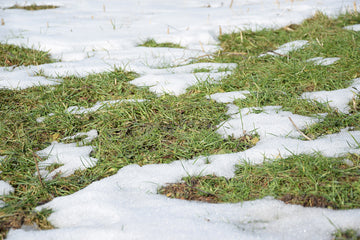Creating a vibrant and healthy lawn as winter gives way to spring requires a green thumb and a strategic approach. The end of winter and early spring is a crucial period for lawn care. As the snow melts and the first signs of green emerge, your lawn needs special attention to recover from winter stresses and prepare for the growing season.
Let’s explore six essential tips to help you transition your lawn from the cold winter months into a thriving spring landscape.
1. Assessing Winter Damage
First and foremost, as the snow melts, assess your lawn for any damage caused by winter conditions. Look out for areas compacted by snow, salt damage near roads and walkways, or signs of disease like snow mold. This initial assessment is crucial as it sets the stage for your spring lawn care strategy.
2. Raking and Cleaning
Once the lawn is mostly clear of snow, start by gently raking the grass. This activity removes leaves and debris that have accumulated over the winter and helps fluff up the grass. Raking is vital in preventing thatch buildup and promoting air circulation to the soil and grass roots.
3. Soil Testing and pH Adjustment
Early spring is an ideal time for soil testing. A soil test reveals vital information about its pH and nutrient levels. Lawns generally thrive in a slightly acidic to neutral pH (around six to seven). If your soil test reveals a pH that is too high or too low, use lime to raise the pH or sulfur to lower it. Proper pH balance ensures that your grass can effectively absorb nutrients.
4. Overseeding Sparse Areas
Winter can be tough on lawns, leading to thinning or bare patches. Overseeding these areas can revitalize your lawn, promoting denser growth. Choose a grass seed that matches your existing lawn and is suitable for your climate. The best time to overseed is when daytime temperatures consistently hit around 15 degrees celsius.
5. Fertilizing
Fertilization is a key component of spring lawn care. However, timing and the type of fertilizer used are crucial. Opt for a slow-release nitrogen fertilizer and follow the instructions closely. Over-fertilizing can burn your lawn and contribute to rapid, weak growth.
6. Proper Mowing Practices
As the lawn starts to grow, begin your mowing routine. Ensure your mower blades are sharp for a clean cut, which is healthier for the grass. Adjust the mower height so that you’re only removing the top third of the grass blade. This height helps in developing a deeper root system, which is essential for a healthy, drought-resistant lawn.
Implementing these tips as you transition from winter to spring can significantly improve the health and appearance of your lawn. Regular maintenance, combined with a keen eye for the unique needs of your turf, will ensure a lush, green lawn that's ready for the months ahead. Similar to you, your lawn’s been waiting all winter to emerge and thrive in the spring and summer. It’s very grateful for all the work you do to help it live its best warm-weather life.





